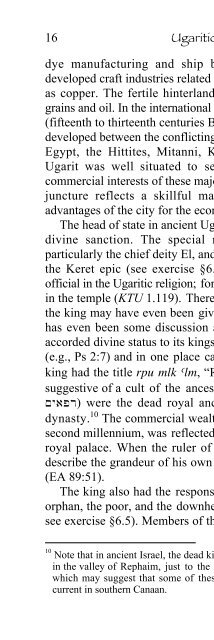A Primer on Ugaritic: Language, Culture, and Literature - enenuru
A Primer on Ugaritic: Language, Culture, and Literature - enenuru
A Primer on Ugaritic: Language, Culture, and Literature - enenuru
Create successful ePaper yourself
Turn your PDF publications into a flip-book with our unique Google optimized e-Paper software.
16<br />
<strong>Ugaritic</strong> <str<strong>on</strong>g>Primer</str<strong>on</strong>g><br />
dye manufacturing <strong>and</strong> ship building. In additi<strong>on</strong>, the city<br />
developed craft industries related to its trade in raw materials such<br />
as copper. The fertile hinterl<strong>and</strong> was also exploited for trade in<br />
grains <strong>and</strong> oil. In the internati<strong>on</strong>al age of the late sec<strong>on</strong>d millennium<br />
(fifteenth to thirteenth centuries BCE), a certain uneasy equilibrium<br />
developed between the c<strong>on</strong>flicting interests of the major powers of<br />
Egypt, the Hittites, Mitanni, Kassite Babyl<strong>on</strong>ia, <strong>and</strong> Assyria.<br />
Ugarit was well situated to serve as an intermediary of the<br />
commercial interests of these major states. The rise of Ugarit at this<br />
juncture reflects a skillful manipulati<strong>on</strong> of the geographical<br />
advantages of the city for the ec<strong>on</strong>omy.<br />
The head of state in ancient Ugarit was the king, whose line had<br />
divine sancti<strong>on</strong>. The special relati<strong>on</strong>ship between the gods,<br />
particularly the chief deity El, <strong>and</strong> the king is clear, for example, in<br />
the Keret epic (see exercise §6.4). The king was the principle<br />
official in the <strong>Ugaritic</strong> religi<strong>on</strong>; for example, the king could sacrifice<br />
in the temple (KTU 1.119). There is some evidence to suggest that<br />
the king may have even been given divine status in Ugarit. There<br />
has even been some discussi<strong>on</strong> as to whether ancient Israel also<br />
accorded divine status to its kings, who were the “s<strong>on</strong>s of Yahweh”<br />
(e.g., Ps 2:7) <strong>and</strong> in <strong>on</strong>e place called }elohim (Ps 45:6). The dead<br />
king had the title rpu mlk {lm, “Rapiu, the eternal king,” which is<br />
suggestive of a cult of the ancestors. The Rapiuma (cp. Hebrew,<br />
Myapr) were the dead royal ancestors, who protected the royal<br />
dynasty. 10 The commercial wealth of Ugarit, especially in the late<br />
sec<strong>on</strong>d millennium, was reflected in the size <strong>and</strong> opulence of the<br />
royal palace. When the ruler of Byblos, for example, wished to<br />
describe the gr<strong>and</strong>eur of his own palace, he compared it to Ugarit<br />
(EA 89:51).<br />
The king also had the resp<strong>on</strong>sibility to defend the widow, the<br />
orphan, the poor, <strong>and</strong> the downhearted ([Aqhat] KTU 1.17 v, 6–8;<br />
see exercise §6.5). Members of the king’s clan exercised c<strong>on</strong>trol in<br />
10 Note that in ancient Israel, the dead kings had funerary pyres burned for them<br />
in the valley of Rephaim, just to the west of Jerusalem (2Chr 16:14; 21:19),<br />
which may suggest that some of these royal rituals <strong>and</strong> theology were also<br />
current in southern Canaan.


